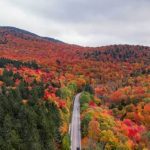 Technology
Technology  Technology
Technology  Humans
Humans 10 Everyday Human Behaviors That Are Actually Survival Instincts
 Animals
Animals 10 Animals That Humiliated and Harmed Historical Leaders
 History
History 10 Most Influential Protests in Modern History
 Creepy
Creepy 10 More Representations of Death from Myth, Legend, and Folktale
 Technology
Technology 10 Scientific Breakthroughs of 2025 That’ll Change Everything
 Our World
Our World 10 Ways Icelandic Culture Makes Other Countries Look Boring
 Misconceptions
Misconceptions 10 Common Misconceptions About the Victorian Era
 Mysteries
Mysteries 10 Strange Unexplained Mysteries of 2025
 Miscellaneous
Miscellaneous 10 of History’s Most Bell-Ringing Finishing Moves
 Technology
Technology Top 10 Everyday Tech Buzzwords That Hide a Darker Past
 Humans
Humans 10 Everyday Human Behaviors That Are Actually Survival Instincts
 Animals
Animals 10 Animals That Humiliated and Harmed Historical Leaders
Who's Behind Listverse?

Jamie Frater
Head Editor
Jamie founded Listverse due to an insatiable desire to share fascinating, obscure, and bizarre facts. He has been a guest speaker on numerous national radio and television stations and is a five time published author.
More About Us History
History 10 Most Influential Protests in Modern History
 Creepy
Creepy 10 More Representations of Death from Myth, Legend, and Folktale
 Technology
Technology 10 Scientific Breakthroughs of 2025 That’ll Change Everything
 Our World
Our World 10 Ways Icelandic Culture Makes Other Countries Look Boring
 Misconceptions
Misconceptions 10 Common Misconceptions About the Victorian Era
 Mysteries
Mysteries 10 Strange Unexplained Mysteries of 2025
 Miscellaneous
Miscellaneous 10 of History’s Most Bell-Ringing Finishing Moves
10 Terrifying and Unfortunate National Park Deaths
National parks attract millions of visitors every year, but with adventure comes risk. The beauty these national parks offer often overshadows the fact that mother nature can be just as dangerous and deadly as it is breathtaking.
Over the years, there have been many incidents in our national parks that have resulted in fatalities. From falls and drownings to animal attacks and other accidents, these tragedies have left a mark on the families and friends of victims.
It’s important to remember that while these deaths are certainly tragic, they are also extremely rare. Millions of people visit national parks every year without incident, and the parks are generally safe and enjoyable places to explore. However, visitors should always be aware of the risks associated with outdoor activities and take appropriate precautions to ensure their own safety. Basically, read the warning signs and listen to the rules.
Let’s explore ten terrifying and unfortunate national park deaths in recent history, the circumstances surrounding each tragedy, and the lessons that can be learned from them. You can use this information on your next trip to one of the nation’s amazing national parks.
Related: 10 Cold Cases of Missing People in National Parks
10 Fall from Half Dome, Yosemite National Park
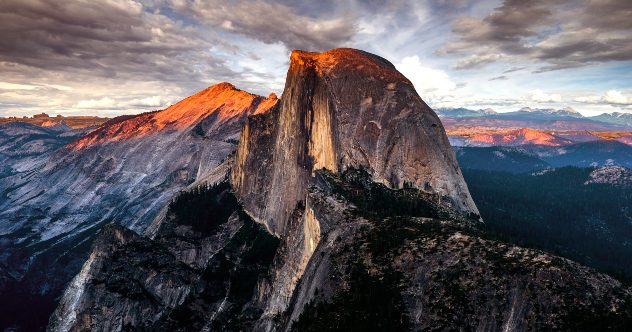
Half Dome in Yosemite National Park is one of the most iconic landmarks in the park. Danielle Burnett, a 29-year-old woman, was hiking when she slipped and fell over 500 feet (152 meters) to her death. She was climbing the top section of Half Dome, an extremely steep and strenuous ascent that requires hikers to use metal cables to pull themselves up the granite dome.
Her tragic death is a reminder of the importance of safety measures in national parks. The Half Dome cables have been a notorious danger zone for hikers. Danielle is at least the 12th person to die while climbing to the summit.
Over time, more safety measures have been added or replaced to try and keep hikers as safe as possible. Half Dome has cables along the path, with which they suggest you use a safety harness. But using one is optional. Wood beams have also been added to let hikers steady themselves and rest when needed. Additionally, daily permits have been capped to limit the number of people on the trail at any given time.
9 Grizzly Bear Attack, Glacier National Park
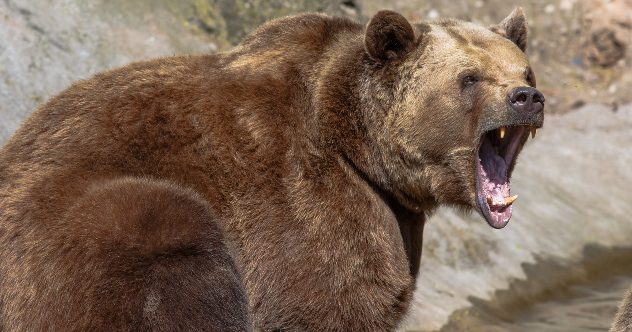
Glacier National Park is a beautiful national park in Montana that offers miles of scenic trails, breathtaking vistas, and some of the most majestic wildlife in the United States. Nearly three million people visit each year to enjoy the natural beauty. This particular death really highlights just how dangerous wild animals can be.
Brad Treat was a 38-year-old officer for the U.S. Forest Service who was mountain biking with a friend when he surprised and collided with a grizzly bear. After the collision, he was thrown from his bike and mauled by the bear as his friend left to get help.
While rare, accidents like this serve as a reminder that visitors to national parks should always respect the wildlife and be prepared for unexpected encounters. If you do encounter a bear, the Forest Service says you should do the following:
- Stay as calm as possible while talking to the bear and slowly waving your arms
- Pick up small children
- Make yourself appear as big as possible
- Don’t run or climb trees
- Don’t act or sound like prey
- Leave the bear an exit and slowly move away
8 Fall from Angel’s Landing, Zion National Park
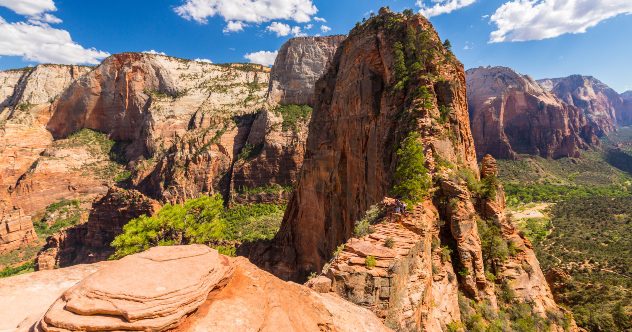
Angel’s Landing is known for its stunning views, but it is also one of the most dangerous hikes in the park. The trail features sheer drop-offs, narrow paths, and steep inclines, requiring hikers to use chains for support.
Despite the danger, Angel’s Landing is still a popular hiking trail in Utah’s Zion National Park. Several fatal accidents have happened on this trail, prompting officials to encourage visitors to use caution or avoid the hike altogether if they’re not experienced.
One of these tragic accidents happened in 2017 when Tate Volino, a 45-year-old man, was hiking when he lost his footing on the steep and narrow trail and fell 1,000 feet (305 meters) to his death. Incidents like these highlight the importance of understanding one’s limits and following safety guidelines in national parks.
7 Flash Flood, Zion National Park
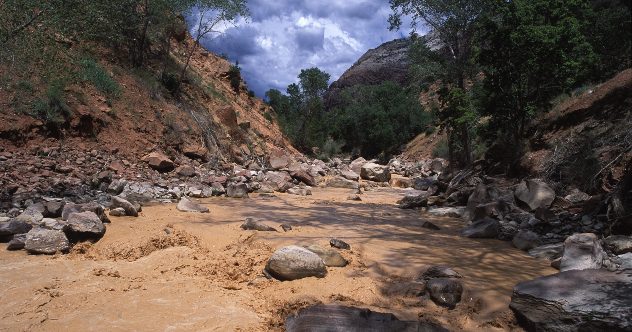
Flash floods are a common danger in slot canyons and other low-lying areas of national parks, especially in Zion National Park’s narrows. When planning a visit, you should always check the weather forecast before starting any hikes and pay special attention to the park’s current flash flood rating. Educating yourself and being prepared could save your life since flash floods can happen in minutes with little warning.
A group of seven hikers was swept away in a flash flood while hiking in Keyhole Canyon during a 2015 storm that dumped over half an inch of rain in one hour. Park officials say that everyone who hikes the canyons is given safety information when they pick up their permit. Still, once in the canyon, there is no way to communicate with people if conditions change suddenly.
If you happen to find yourself in an area prone to flooding, you should look for these signs to be as safe as possible.
- Puddles are beginning to form
- Change in water color of an existing stream.
- Existing water source has an increase in debris.
- You can hear rushing water.
Hopefully, you’ll never be caught in this situation, but if you see the signs or are caught in a flash flood, knowing what to do can save your life. Higher ground is your best chance. While getting out of the canyon is ideal, remember you can outrun a flash flood. Other things to increase your chance of survival are:
- Don’t swim in or try crossing a flood
- Try avoiding climbing onto rocks or shelves if possible. You might end up stranded or forced to swim if the water rises too much.
- If you’re stranded, stay put and let the water go down.
6 Lightning Strike, Rocky Mountain National Park
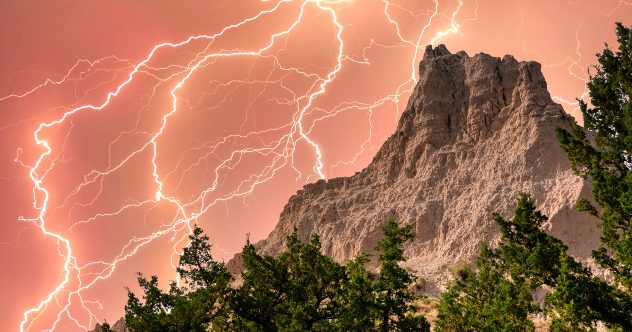
Lightning strikes are a fairly common danger in national parks, particularly in high-altitude areas. National park officials urge visitors to check the weather forecast and to avoid hiking during thunderstorms or high winds. If caught in a thunderstorm, hikers should seek shelter in a low-lying area or a building if available. It is also crucial to avoid open spaces, tall trees, and metal objects, which can attract lightning.
In 2014, a tragedy occurred at Rocky Mountain National Park in Colorado when a group was struck by lightning. The strike killed one and injured seven others. While it’s miraculous that so many in the group survived the lightning strike, backpackers and hikers should always pay attention to the weather and plan their excursions accordingly.
5 Fall from the Grand Canyon, Grand Canyon National Park
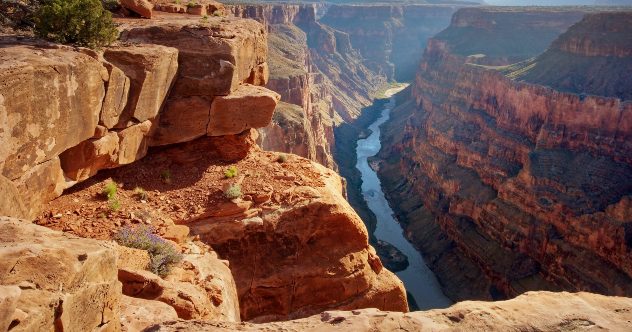
In April 2018, a 35-year-old man fell to his death while taking photos near the edge of the Grand Canyon in Arizona. The man reportedly backed up to take a photo when he lost his footing and fell 1,000 feet (305 meters) to his death. The incident is just one of many fatal falls that have occurred at the Grand Canyon over the years.
The Grand Canyon is one of the most popular national parks in the United States, attracting millions of visitors each year. However, the park’s steep cliffs and rugged terrain can be dangerous, especially for those who venture too close to the edge. Each year around a dozen people die in the park, with several of those deaths caused by accidentally falling.
Visitors should always stay on designated trails, avoid getting too close to the edge, and keep a close eye on children and pets.
4 Drowning, Great Smoky Mountains National Park
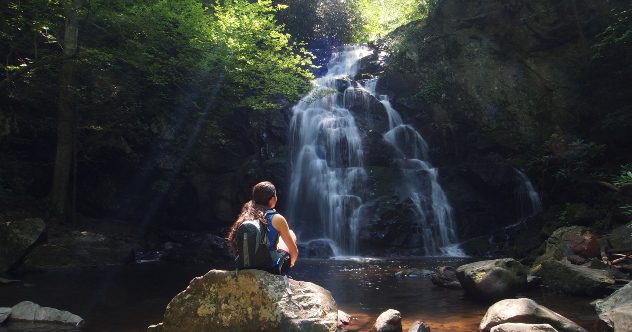
When hiking through on a hot summer day, it can be tempting to go for a swim to cool off and enjoy the park’s natural beauty. But the National Park Service says that swimming and other water activities are not recommended since there are no designated swimming areas. If an injury happens, help could be hours away.
In 2022, a man drowned while kayaking near the Sinks in the Great Smoky Mountains National Park. Park officials were called after the 61-year-old fell into the water and didn’t resurface.
This tragic incident highlights the dangers of natural bodies of water, particularly in areas with strong currents or deep pools. Shifting rocks and seemingly slow currents are enough to quickly turn a fun outing into a tragedy. Park officials remind visitors to never swim alone, to avoid diving or jumping from high cliffs or rocks, and to always wear appropriate safety gear.
3 Plane Crash, Denali National Park

Denali National Park is known for its rugged wilderness and stunning beauty, but it can also be a dangerous place for those who don’t exercise caution. Visitors are advised to always follow park guidelines and to be aware of the inherent risks associated with backcountry travel and other outdoor activities.
In 2018, a small sightseeing plane carrying a pilot and four passengers crashed in Denali National Park. All five people on board were killed in the crash. What makes this incident especially tragic is that while the crash was found initially, rescue and recovery weren’t possible. Following an earthquake in the area, a portion of the mountain collapsed, and now the crash can’t be found.
2 Heatstroke, Joshua Tree National Park
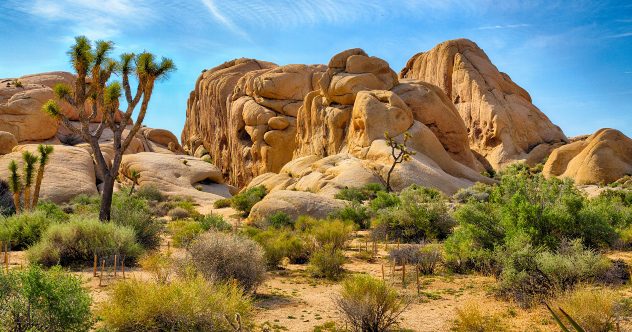
In 2018, a hiker died from heatstroke while hiking in Joshua Tree National Park in the California desert. This is a major concern when visiting the park, as temperatures can reach well over 100°F (37.8°C).
This tragic incident highlights the dangers of hiking in extreme heat, particularly in arid environments like Joshua Tree National Park. To avoid heat stroke while hiking, it is important to stay hydrated by drinking plenty of water and electrolyte-rich fluids, such as sports drinks. Wearing loose-fitting, breathable clothing and a wide-brimmed hat can also help protect against heat exhaustion.
If someone begins to show signs of heatstroke, such as dizziness, confusion, or rapid heartbeat, move them to a shaded area, provide cool water, and seek medical attention immediately. To prevent heat stroke from occurring, acclimate to the environment by gradually increasing activity levels and avoiding strenuous activity during the hottest part of the day.
1 Falling Tree, Great Smoky Mountains National Park
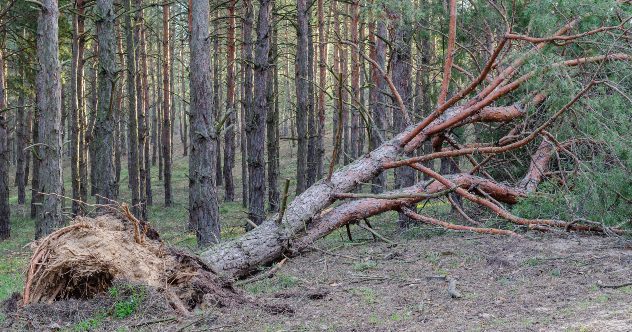
Admittedly, this one is a rarity, but the fact that a seven-year-old girl was killed makes it all the more tragic.
In July 2022, park rangers in the Great Smoky Mountains National Park were called just after midnight. A dad was camping with his three daughters when a 2-foot-wide (0.6=meter) red maple tree fell on their tent, killing his seven-year-old daughter. The rest of the family was physically unhurt.
Investigators weren’t sure why the tree fell but said that this is the first death caused by a falling tree on a tent in the park’s history.
